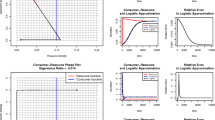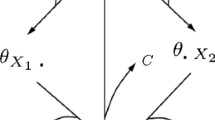Abstract
A graphical technique is given for determining the outcome of two species competition for two resources. This method is unifying in the sense that the graphical criterion leading to the various outcomes of competition are consistent across most of the spectrum of resource types (from those that fulfill the same growth needs to those that fulfill different needs) regardless of the classification method used, and the resulting graphs bear a striking resemblance to the well-known phase portraits for two species Lotka–Volterra competition. Our graphical method complements that of Tilman. Both include zero net growth isoclines. However, instead of using the consumption vectors at potential coexistence equilibria to determine input resource concentrations leading to specific competitive outcomes, we introduce curves bounding the feasible set (the set where the resource concentrations of any equilibrium solution must be located). The washout equilibrium (corresponding to the supply point) occurs at an intersection of curves defining the feasible set boundary. The resource concentrations of all other equilibria are found where zero net growth isoclines either intersect each other inside the feasible set or they intersect the feasible set boundary. A species has positive biomass at such an equilibrium only if its zero net growth isocline is involved in such an intersection. The competitive outcomes are then determined from the position of the single species equilibria, just as in the phase portrait analysis for classical competition (rather than from information at potential coexistence equilibria as in Tilman’s method).
Similar content being viewed by others
References
Bader F (1978) Analysis of double-substrate limited growth. Biotechnol Bioeng 20: 183–202
Bader F, Meyer J, Fredrickson A, Tsuchiya H (1975) Comments on microbial growth rate. Biotechnol Bioeng 17: 279–283
Ballyk MM, Wolkowicz GSK (1993) Exploitative competition in the chemostat on two perfectly substitutable resources. Math Biosci 118: 127–180
Ballyk MM, Wolkowicz GSK (1995) An examination of the thresholds of enrichment: a resource-based growth model. J Math Biol 33: 435–457
Ballyk MM, McCluskey CC, Wolkowicz GSK (2005) Global analysis of competition for perfectly substitutable resources with linear response. J Math Biol 51: 458–490
Butler GJ, Wolkowicz GSK (1985) A mathematical model of the chemostat with a general class of functions describing nutrient uptake. SIAM J Appl Math 45(1): 138–151
Butler GJ, Wolkowicz GSK (1987) Exploitative competition in the chemostat for two complementary, and possibly inhibitory, resource. Math Biosci 83: 1–48
Egli T (1995) The ecological and physiological significance of the growth of heterotrophic microorganisms with mixtures of substrates. Adv Microb Ecol 14: 305–386
Freedman HI, Waltman P (1984) Persistence in models of three interacting predator-prey populations. Math Biosci 68: 213–231
Gause GF (1934) The struggle for existence. Williams and Wilkins, Baltimore
Grover JP (1997) Resource competition. Population and community biology series 19. Chapman and Hall, New York
Harder W, Dijkhuizen L (1976) Mixed substrate utilization in microorganisms. In: Dean ACR, Ellwood DC, Evans CGT, Melling J (eds) Continuous culture, (Applications and newfields), vol 6. Ellis Horwood, Chichester and Oxford, pp 297–314
Hsu SB (1978) Limiting behavior for competing species. SIAM J Appl Math 34: 760–763
Hsu SB, Hubbell SP, Waltman P (1977) A mathematical theory of single nutrient competition in continuous cultures for microorganisms. SIAM J Appl Math 32: 366–383
Hsu SB, Cheng KS, Hubbell SP (1981) Exploitative competition of microorganisms for two complementary nutrients in continuous culture. SIAM J Appl Math 41: 422–444
Huisman J, Weissing FJ (1999) Biodiversity of plankton by species oscillations and chaos. Nature 402: 407–410
León JA, Tumpson DB (1975) Competition between two species for two complementary or substitutable resources. J Theor Biol 50: 185–2012
Li B (1999) Global asymptotic behavior of the chemostat: general response functions and differential death rates. SIAM J Appl Math 59: 411–422
Li B, Smith HL (2001) How many species can two essential resources support?. SIAM J Appl Math 62: 336–366
Lotka AJ (1925) Elements of physical biology. Williams and Wilkins, Baltimore
Phillips O (1973) The equilibrium and stability of simple marine biological systems i. primary nutrient consumers. Am Nat 107: 73–93
Pilyugin SS, Reeves GT, Narang A (2004) Predicting stability of mixed microbial cultures from single species experiments: 1. Phenomenological model. Math Biosci 192: 85–105
Rapport DJ (1971) An optimization model of food selections. Am Nat 105: 575–587
Tilman D (1980) Resources: a graphical-mechanistic approach to competition and predation. Am Nat 116: 362–393
Tilman D (1982) Resource competition and community structure. Princeton University Press, New Jersey
Verhulst PF (1838) Notice sur la loi que la population suit dans son accroissement. Correspondance Mathematique et Physique 10: 113–121
Volterra V (1928) Variations and fluctuations of the number of individuals in animal species living together. J Conserv (Conserv Int Explor Mer) 3: 3–51
Waltman P, Hubbell SP, Hsu SB (1980) Theoretical and experimental investigations of microbial competition in continuous culture. In: Burton T (ed) Modeling and differential equations. Marcel Dekker, New York, pp 107–152
Wolkowicz GSK, Lu Z (1992) Global dynamics of a mathematical model of competition in the chemostat: general response functions and differential death rates. SIAM J Appl Math 52(1): 222–233
Wolkowicz GSK, Xia H (1997) Global asymptotic behavior of a chemostat model with discrete delays. SIAM J Appl Math 57(4): 1019–1043
Wolkowicz GSK, Xia H, Ruan S (1997) Competition in the chemostat: a distributed delay model and its global asymptotic behavior. SIAM J Appl Math 57(5): 1281–1310
Wolkowicz GSK, Xia H, Wu J (1999) Global dynamics of a chemostat competition model with distributed delay. J Math Biol 38: 285–316
Author information
Authors and Affiliations
Corresponding author
Rights and permissions
About this article
Cite this article
Ballyk, M.M., Wolkowicz, G.S.K. Classical and resource-based competition: a unifying graphical approach. J. Math. Biol. 62, 81–109 (2011). https://doi.org/10.1007/s00285-010-0328-x
Received:
Revised:
Published:
Issue Date:
DOI: https://doi.org/10.1007/s00285-010-0328-x
Keywords
- Multiple resource limitation
- Perfectly substitutable
- Essential
- Complementary
- Homologous
- Heterologous
- Interactive
- Non-interactive
- Lotka–Volterra competition
- Chemostat
- Graphial analysis




